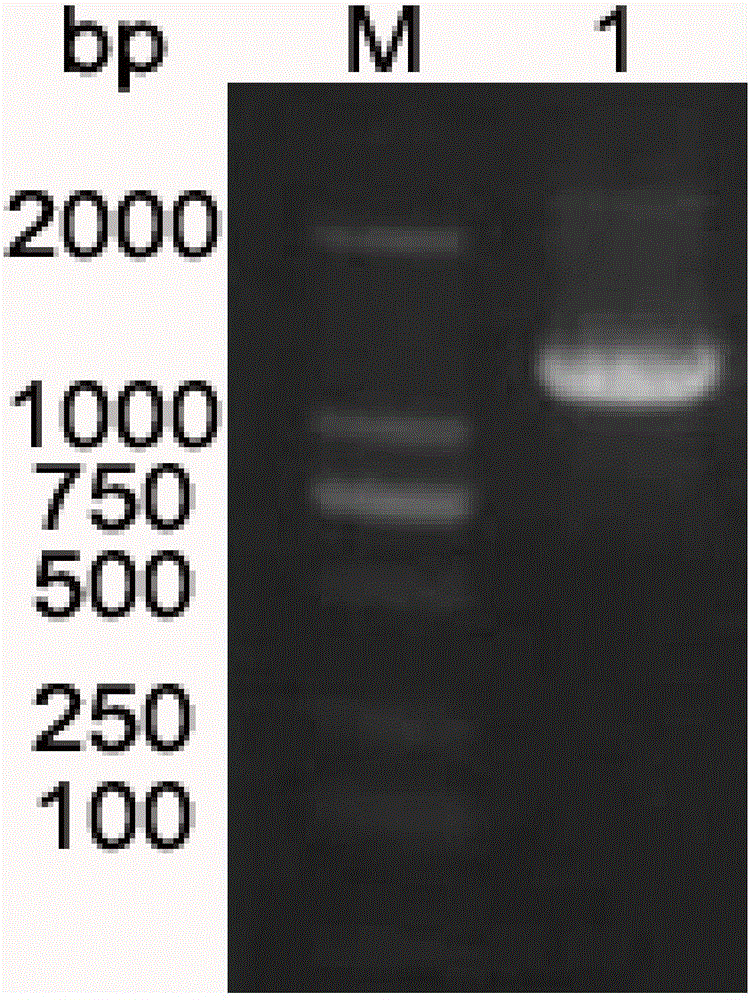Escherichia coli DNA photolyase and construction method thereof
A technology of Escherichia coli and photorepair enzyme, which is applied in recombinant DNA technology, botanical equipment and methods, biochemical equipment and methods, etc., can solve the problems of low antioxidant capacity and poor stability, and achieve stable activity and antioxidant effect. improved effect
- Summary
- Abstract
- Description
- Claims
- Application Information
AI Technical Summary
Problems solved by technology
Method used
Image
Examples
Embodiment 1
[0028] 1. Obtain the phr of WT E. coli photorepair enzyme gene
[0029] Design primers by known Escherichiacoli (cyclobutanepyrimidinedimer, CPDase, EC4.1.99.3) (WT) gene, and use E.coli genomic DNA as a template to amplify the target fragment (such as figure 1 ). The phr amplification primers and PCR conditions are:
[0030] phrF(NdeI): 5′-CTCCATATGACTACCCATCTGGTCTG-3′
[0031] phrR(XhoI): 5′-GTGCTCGAGTTTCCCCTTCCGCGCC-3′
[0032] Pre-denaturation at 95°C for 5 minutes; 30 cycles at 94°C for 30s, 60°C for 30s, 72°C for 2 minutes; Full extension at 72°C for 10 minutes.
[0033] 2. Construct the recombinant vector pET22b-phr
[0034] The amplified gene fragment and plasmid pET22b were digested with NdeI and XhoI, ligated at 16°C for 20h, and transformed into E.coliDH5α. The positive transformants were screened out and the recombinant plasmid pET22b-phr was obtained. After the double enzyme digestion and identification, it was sent to Nanjing GenScript Biotech Co., Ltd. for sequencing. T...
Embodiment 2
[0044] Example 2: A377S activity test.
[0045] The E. coli DNA photorepair enzyme contains two coenzymes, namely methine tetrahydrofolate (MTHF) and flavin adenine dinucleotide (FAD). MTHF has the effect of enhancing the activity of light repair enzymes. While FAD makes enzymes have photoremediation activity, FAD has three existing forms, oxidation state, free radical state and reduction state. Therefore, the types of E.coliCPDase can be divided into oxidized type, free radical type and reduced type. Among the three types of E. coli CPDase, only the reduced E. coli CPDase has photorepair activity, with a specific absorption wavelength of about 360 nm of visible light; while the oxidized and free radical types of E. coli CPDase have no photorepair enzyme activity. The oxidized E.coliCPDase specifically absorbs visible light with a wavelength of about 450nm, and does not absorb visible light with a wavelength above 550nm. The free radical E.coliCPDase specifically absorbs visib...
Embodiment 3
[0049] Example 3: Antioxidant ability of A377S.
[0050] In the air, the oxidation process of E. coli DNA photorepair enzyme changes from free radical E.coliCPDase to oxidized E.coliCPDase, that is, the free radical E.coliCPDase keeps decreasing, and the oxidized E.coliCPDase keeps increasing. The oxidized E.coliCPDase specifically absorbs visible light with a wavelength of about 450nm, and does not absorb visible light with a wavelength above 550nm. The free radical E.coliCPDase specifically absorbs visible light with a wavelength of about 580nm. Therefore, the photoremediation enzyme oxidation process includes two features. One feature is that the absorbance of visible light with a wavelength of about 580nm gradually decreases until it stabilizes; the other feature is that the absorbance of visible light with a wavelength of about 450nm gradually rises until it stabilizes. Store the purified DNA photorepair enzyme at 4°C. At regular intervals, draw 800μl of purified enzyme so...
PUM
 Login to View More
Login to View More Abstract
Description
Claims
Application Information
 Login to View More
Login to View More - R&D
- Intellectual Property
- Life Sciences
- Materials
- Tech Scout
- Unparalleled Data Quality
- Higher Quality Content
- 60% Fewer Hallucinations
Browse by: Latest US Patents, China's latest patents, Technical Efficacy Thesaurus, Application Domain, Technology Topic, Popular Technical Reports.
© 2025 PatSnap. All rights reserved.Legal|Privacy policy|Modern Slavery Act Transparency Statement|Sitemap|About US| Contact US: help@patsnap.com



